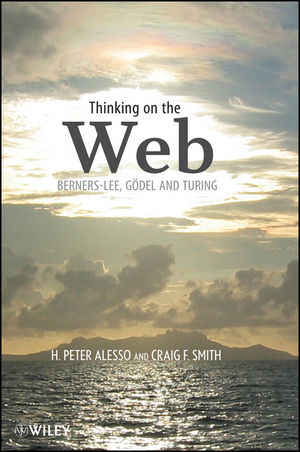Thinking on the Web: Berners-Lee, Gödel, and TuringISBN: 978-0-471-76866-1
Paperback
328 pages
November 2008
 This is a Print-on-Demand title. It will be printed specifically to fill your order. Please allow an additional 10-15 days delivery time. The book is not returnable.
|
||||||
The Purpose of this Book.
Who Should Read this Book.
The Organization of this Book.
PART I: WHAT IS WEB INTELLIGENCE.
Chapter 1: The Information Age and the Web.
Overview.
Thinking and Intelligent Web Applications.
The Information Age.
The World Wide Web.
The Limitations of Today’s Web.
The Next Generation Web.
Why Intelligent Ubiquitous Devices Improve Productivity.
Conclusion.
Exercises.
Interlude #1 Thinking about Thinking.
Chapter 2: Gödel - What is Decidable?
Overview.
Philosophical and Mathematical Logic.
Kurt Gödel.
Knowledge Representation.
Computational Logic .
Artificial Intelligence.
Web Architecture and Business Logic.
The Semantic Web.
Conclusion.
Exercises.
Interlude #2 Truth and Beauty.
Chapter 3: Turing - What is Machine Intelligence?
Overview.
What is Machine Intelligence?
Alan Turing.
What is Machine Intelligence?
Turing Test and the Loebner Prize .
John Searle’s Chinese Room.
Artificial Intelligence.
Machine Intelligence .
Semantic Networks and Frames.
Reasoning with Semantic Networks.
Computational Complexity.
Description Logic (DL).
Ontology.
Inference Engines.
Software Agents.
Adaptive Software.
Limitations and Capabilities.
Conclusion.
Exercises.
Interlude #3: Computing Machines.
Chapter 4: Berners-Lee ? What is Solvable on the Web?
Overview.
The World Wide Web.
Berners-Lee.
Competing Web Standards.
The Semantic Web Roadmap.
Semantic Web Services.
Logic on the Semantic Web.
Semantic Web Capabilities and Limitations.
Conclusion.
Exercises.
Interlude #4 Turing’s Test.
PART II: WEB ONTOLOGY AND LOGIC.
Chapter 5: Resource Framework Description -- RDF.
Overview .
HTML Language.
XML Language.
RDF Language.
Basic Elements.
RDF Schema.
XQuery - XML Query Language.
Conclusion .
Exercises.
Interlude #5 The Chinese Room.
Chapter 6: Web Ontology Language -- OWL.
Overview.
Ontology Language.
Ontology Language Requirements.
Compatibility of OWL and RDF/RDFS.
The OWL Language.
Basic Elements.
OWL Example -- Compute Ontology.
Ontology Example -- Birthplace.
Applying OWL.
OWL Capabilities and Limitations.
Conclusion.
Exercises.
Interlude #6: Machines and Brains.
Chapter 7: Ontology Engineering.
Overview.
Ontology Engineering.
Constructing Ontologies.
Ontology Example.
Ontology Methods.
Ontology Libraries.
Ontology Matching.
Ontology Mapping .
Ontology Mapping Tools .
Conclusion.
Exercises.
Interlude #7: Machines and Meaning.
Chapter 8: Logic, Inference and Rule Systems.
Overview.
Logic and Inference.
Monotonic and Nonmonotonic Rules.
Descriptive Logic.
Inference Engines.
Example RDF Inference Engine.
Conclusion.
Exercises.
Interlude #8: Machines and Rules.
Chapter 9: Semantic Web Rule Language -- SWRL.
Overview.
Rule Systems.
Rule Languages.
Semantic Web Rule Language (SWRL).
Conclusion.
Exercises.
Interlude #9: Machines and Language.
Chapter 10: Semantic Web Applications.
Overview.
Semantic Web Applications .
Web Services.
Semantic Search.
e-Learning .
Semantic Web and Bio-Informatics .
Enterprise Application Integration.
On-To-Knowledge (OTK) .
Knowledge Base.
Conclusion.
Exercise.
Interlude #10: Distributed Intelligence.
Chapter 11: Web Ontology Language for Services -- OWL-S.
Overview.
XML-Based Web Services.
Next Generation Web Services .
OWL-S Primer.
Creating an OWL-S Ontology for a Web Services.
Conclusion.
Exercises.
Interlude #11: The Semantic Web.
Chapter 12: Semantic Search Technology.
Overview.
Search Engines .
Semantic Search.
Semantic Search Technology.
Web Search Agents.
Semantic Methods.
Latent Semantic Index Search.
TAP.
Swoogle.
Conclusion.
Exercises.
Interlude #12: The Halting Problem.
Chapter 13: Semantic Patterns and Adoptive Software.
Overview .
Patterns in Software Design.
Pattern Frame.
Semantic Patterns.
Self-Organizing and Adaptive Software.
Conclusion.
Exercises.
Interlude #13: The Semantic Web and Meaning.
Chapter 14: Semantic Tools.
Overview .
Semantic Tools.
Semantic Web Services Tools.
Conclusion.
Interlude #14: The Semantic Web and Language.
Chapter 15: Opportunities and Challenges.
Overview.
Semantic Doubt.
Semantic Opportunities.
Challenges.
Balancing Proprietary and Open Standards.
Conclusion.
Interlude #15: The Semantic Web and Zeno’s Paradox.
Bibliography.
Glossary.
List of Acronyms.
Index.



